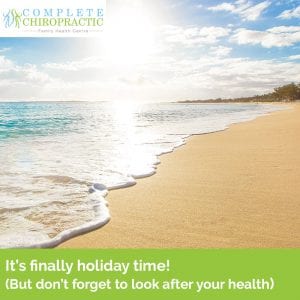School’s out and for many of us, that means its time for a well-earned break, be it an activity-packed family holiday or an all-inclusive luxury chill out. Time of work is great for the mind but can also be an excellent opportunity to recharge your body. Unfortunately, thousands of people are injured each year whilst on holiday, and as you might expect there are some common themes! This week, let’s look at some common holiday problems and how you can avoid them.
Avoid back strain
One of the most common holiday-related injuries often takes place before we have even left the house! You’ve spent days (or perhaps just a few hectic hours) stuffing your suitcases with every conceivable item you may require, and now it’s a rush to get everything into the car or taxi. You might have already spotted the potential problem – this is a recipe for back injury!
When undertaking any kind of lifting you should always ensure you practice “safe lifting” Practically, this means you should…
- Start with your body as close to the load as possible, avoiding reaching out to grasp it. This keeps your centre of gravity where it should be.
- Avoid reaching over your head – use a ladder instead.
- Focus on your legs when lifting – shifting your mental focus has been shown to activate muscle groups more effectively.
- Don ‘t arch or twist your back – keep it straight.
- Hold the load close to your torso between your shoulders and waist for minimal back strain.
Reading these points may well explain why so many back injuries are attributable to suitcases! The shape, uneven loading and the fact there is often only one handle to grasp the case by making safe lifting hard here – lifting with only one side of the body decreases the stability of the spine, putting individuals at risk.[1]
What’s worst, numerous studies have suggested that not knowing roughly how heavy a load is before lifting subconsciously influences posture, balance and spinal load. Lifting an object that is heavier than anticipated can throw your body off balance, especially if you are already in a less-than optimal lifting posture and strain the lumbar region.[2]
Evidence also suggests that trying to lift items quickly also increases the risk of injury[3] meaning that that last-minute rush really is a high-risk activity.
Avoid potential problems here by.
- Packing early – don’t rush!
- Getting assistance with lifting the suitcases, put one person on each side of a large case
- Try to travel light (you’ll want to bring more stuff back anyway!)
- Choosing a suitcase with integrated wheels, which significantly reduces the amount of lifting required
- Packing two smaller suitcases, rather than one large one, if your airline will allow it
- Asking for help from your taxi driver, or at the airport
Be cautious of heat related illness
It no secret that we Brits are terrible when it comes to sun hygiene. It’s understandable since for so much of the year we’re stuck with grey and rainy weather, but the consequence of not being mindful in the heat can be a holiday running illness.
The main concerns in the sun are heat exhaustion and heat stroke, both of which are attributable to too much time spent out in the open sun, without proper hydration and with excessive activity. You’re especially at risk if you’re on holiday as a family with young children or older relatives, who are most likely to suffer.
Avoiding heat-related illness is, however, quite simple to do. Wherever possible try not to undertake physical activity during the hottest part of the day – instead, spend this time around the pool or in the shade. Temperatures are generally highest between 12 and 4 PM, so schedule physical activities for the morning, or later afternoon.
Try to make sure you take short “sun breaks” even if you’re around the pool, or out on the beach. Ideally, get a two- to five-minute break for every 15 minutes of sun exposure. If you’re active for longer, you should take a longer break – 15 minutes after 45 minutes of activity.
Don’t get dehydrated!
Dehydration is by far the most common issue on hot days (whether you’re being physically active or not) and since sweating is responsible for much heat-induced water loss, you should dress appropriately for the heat, meaning loose, light-coloured clothing with appropriate sun protection – this will help you to sweat more effectively, and therefore lose less water.
In the heat (but always, as a good rule) you should never wait until you a thirsty to drink – instead, schedule regular water breaks – doing this while you are taking some time in the shade works well. If you are usually quite bad at remembering to drink enough water, consider setting an alarm on your phone. Every 15 to 30 minutes works well. Generally, thirst should be considered as a sign that you are already dehydrated so if you do find yourself getting thirsty stop what you are doing and rehydrate. Rehydration drinks can be useful if you know how to use them appropriately – but never use them as a substitute for water.
Feel the burn… (or don’t)
Sunburn is, for many of us, a part of the holiday experience – but its also associated with risk of skin cancer and if were honest, looks a bit silly!
Having said this, some direct exposure to the sun is likely to be a health benefit, since sunlight, specifically UVB rays, are necessary for the body’s production of vitamin D – a vitamin in which the majority of us are deficient. The exact amount of sun exposure needed for ideal vitamin D production involves several variables. such as time of day and location. UVB is most plentiful in the midday sun from about 10:00 to 3:00. UVB also penetrates lighter skin quicker than darker skin, so people with darker skin will need to spend more time in the sun to produce the same amount of vitamin D.
Most experts agree that an appropriate amount of sun exposure should just barely begin to turn the skin pink. Depending on the circumstances, this is generally between 5 minutes and 30- minutes.
After appropriate exposure, simply seek the shade or block further UV rays with clothing and a safe and natural sun screen, since any longer exposure than this will tend to cause damage rather than promote health. It’s for this reason that sunbathing without sunscreen is probably always a bad idea – falling asleep without protection can be a real problem.
All commercial sunscreens contain active ingredients to protect against UVB rays. The sun protection factor (SPF) on a bottle of sunscreen indicates the level of protection the product provides compared to unprotected skin. But here’s an important point – the relationship between SPF number and the actual protection provided is not a linear one, in fact, according to the American Cancer Society, a sun screen labelled SPF 55 is less than two percent more effective than one labelled SPF 30. Higher SPF varieties may also contain more possibly harmful chemicals, so the choice isn’t always a simple as it’s made out to be!
Happy Holidays!
We wish all of our clients happy holidays this month, you’ve all earned a break! Don’t forget that if you do arrive back home feeling a bit stiff (especially after a long flight) a quick adjustment could be exactly what the doctor ordered. As always, early prevention is the best approach.
[1] Spine 2003; 28:764-70
[2] Arch Phys Med Rehabil/ 2002;83 :48-59
[3] J Adv Nursing 201 1; Epub


